

 The South African
The South African
Allan Sinclair
Curator of the Military Art Collection at the South African National Museum of Military HistoryLarge numbers of Boers were taken prisoner after battles such as Elandslaagte (21 October 1899) and Paardeberg (18-27 February 1900). Initially, the POWs were sent to camps in Cape Town and Simon's Town. When it became apparent that these would soon be full, a decision was taken to send them out of South Africa to the island of St Helena. By 1902, there were three camps on the island. The number of Boer prisoners continued to increase as the war progressed, leading to further camps being established in Bermuda, Ceylon (Sri Lanka), and India. It is estimated that, by the end of the war, some 26 000 prisoners of war had passed through these camps.(1)
Life in the camps was generally tedious and the longing for home, loved ones, family, the veld and the fatherland led to much grieving and sadness amongst the prisoners. To combat this, numerous activities were introduced to keep the prisoners occupied. One of these activities was the production of a wide variety of hand craft.(2) Thus, the making of curios, toys and many other kinds of artifacts by the prisoners began as an attempt to while away the hours and relieve some of the boredom in the camp. As time passed, however, a thriving home industry developed in most of the camps and the POWs were able to earn money through the sale of their handcraft.(3)
At first, the most commonly used tool for the production of handcraft by the Boers was the pocket knife. Nearly every burgher on commando had one of these. In his 1967 Huisgenoot article, 'Hul knupmesse het 'n boodskap gekerf', J J Oberholzer points out that, in certain camps, the POWs were able to purchase better equipment such as saws and files with the money earned from sales.(4) Oosthuizen, in his work, Boer War Memorabilia: The Collector's Guide, states that, in their efforts to earn more money, the mass-production of some items, such as walking sticks, pens, boxes, clips, serviette rings and paper knives, became a common practice. He goes on to say, however, that the creation of intricate, detailed models also continued.(5)
An example of Boer POW handeraft on display at the Museum is a carved wooden box. Unfortunately, not much is known about this beautiful item, which was donated to the Museum by Mr G Ravnö in 1993. While a relative of Mr Ravnö' was a POW on St Helena, it is uncertain whether he made the box. Although Mr Oberholzer mentions that many of the POWs were able to purchase saws and files, and so on, with money that they earned, Brohier, in his work on POWs in Ceylon, writes that, 'not having the tools, they devised planes out of table-knives, saws out of barrel-hoops and, with the aid of these and other improvised implements, turned out souvenirs and multitudinous articles of utility, most of them from waste material.'(6)
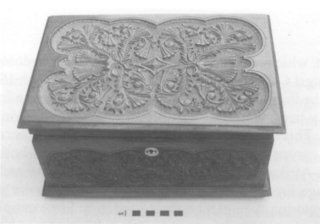
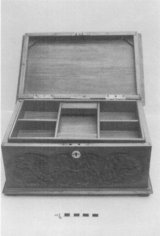
Carved wooden box from a camp on St Helena, Cat 3664, POW Collection,
and with lid open, SA National Museum of Military History (Photo: SANMMH);
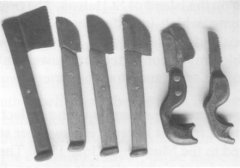
Set of saws from a camp in Ceylon. The saw second from the right
carries the manufacturer's plate 'H Disstons & Sons,'
Cat 3858, POW Collection (Photo: SANMMH);
It was common practice for items to be marked with special labels, including such details as the date, the name of the camp, the country in which the camp was located and, in many cases, the name of the prisoner who created the piece.(7) On display at the Museum are three ebony paper knives. All three knives were manufactured in Ceylon. The first knife was made in Diyatalawa Camp and bears the inscription, 'Diyatalawa - Kamp 1902 van A H B aan Teunis Huisman'. Presumably, the knife-maker was a POW who had the initials A H B and who made the knife for a friend named Teunis Huisman. The second knife, which resembles a type of edged weapon common amongst Ceylonese natives, is in scribed, 'Ceylon 1901', and the third is inscribed 'Ceylon 902'. There is a fourth ebony paper knife in the collection, but it is not on display. This knife is about twice the size of the others and has, carved on the blade, the coats of arms of both the Zuid-Afrikaansche Republiek (the Transvaal) and the Orange Free State. In many cases the POWs were given an opportunity to exhibit their handcraft. For example, in November 1900, an arts and crafts exhibition was held in Jamestown on the island of St Helena. The prisoners contributed items, which included models of carts, carved boxes, pipes and walking sticks. Of the tools used, including old table knives converted into saws, umbrella wire turned into fret saws and stone hammers, were also exhibited.(8)
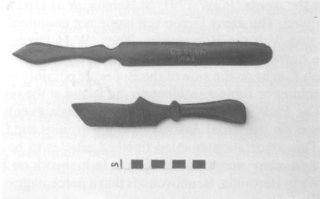
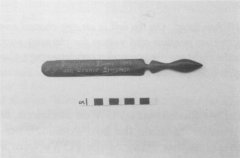
Ebony paper knives from Ceylon. Cats 2981, 2982 and 2983 POW Collection (Photos: SANMMH)
The bottom knife on the left resembles a type of edged weapon used by Ceylonese natives;
the single knife bears the initials 'A.H.B.'
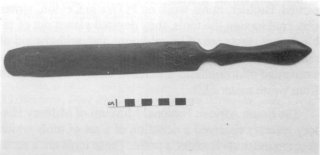
Ebony paper knife made in Ceylon, with the coats of arms of the
ZAR and OFS carved on the blade, Cat 3624, POW Collection. (Photo: SANMMH)
Another interesting example in the collection, which also originates from St Helena, is a swagger stick, which was donated to the Museum in July 1978. The top of the stick is shaped into a claw clenching an egg. Beneath the claw the words 'POW 1901, St Helena, W H Dixon' are engraved. The name Dixon is a name not commonly associated with the Boer forces. Thus, W H Dixon may have been a member of one of the foreign contingents which fought on the side of the Boers, or possibly a British soldier or subject resident on the island at the time.
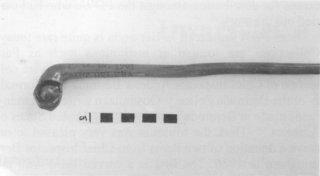
Swagger stick with the top shaped into a claw clenching an egg,
made in St Helena in 1901, Cat 3548, POW Collection. (Photo: SANMMH);
The POWs on Burt's Island in Bermuda eventually formed the Industrial Association for Carvings aud Curios. This association enabled finished articles to be sold through many stores in Bermuda.(9) In his work on Boer POWs in Bermuda, Benbow adds that a percentage of the profits from the sale of the handcraft was returned to the camps for distribution amongst the POWs who had carried out the work.(10)
Boer POW handcraft in Bermuda is quite rare today. Collections are located at institutions such as Par-La-Ville Museum, Fort St Catherine and the private collection of Chief Inspector Andrew Bermingham, formally of the Bermuda Police.(11) Oosthuizen writes that many items made in Bermuda were sent to the United States of America.(12) Thus, the Museum was very pleased to receive a donation of two items from Chief Inspector Bermingham in 1986. The first is a carved hand with the Bible and the second is a paper knife. There has been a suggestion, however, that these two items may be replicas of originals held in the Chief Inspector's collection.
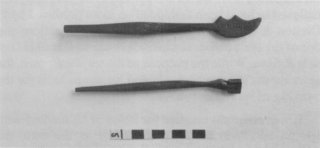
A paper knife and carved hand and bible donated by Chief Inspector Andrew Bermingham.
These items may be replicas of originals in Bermuda, Cat 2984, POW Collection. (Photo: SANMMH).
There are also a number of other interesting items in the Museum's collection which come from Bermuda. One example is a set of carved riding boots, donated in 1988. Each boot has a sliding lid from which a model of a snake with a pin resembling a fang shoots out when opened. Benbow suggests that the snake may be a symbol of the guerrilla warfare.(13)

A set of carved riding boots, made in Bermuda, cat 3454,
POW Collection. The snake is believed to symbolise guerrilla
warfare. (Photo: SANMMH)
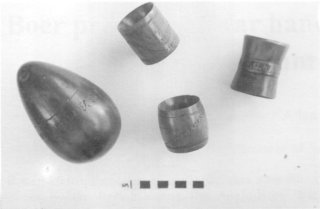
Boer POW handcraft. On the left is an egg-shaped container
used for storing needles and cotton for darning socks, Cat 3429.
On the right are three wooden serviette rings, Cat 3430.
POW Collection. (Photo: SANMMH)
References
1. B Farwell, The Great Boer War (Allen-Lane, London, 1976), pp 420, 421.
2. J J Oberholzer, 'Hul knupmesse het 'n boodskap gekerf' in
Die Huisgenoot, 24 February 1967, p24.
3. Oberholzer, 'Hul knupmesse het 'n boodskap gekerf', p24;
P Oosthuizen, Boer War Memorabilia: The Collector's Guide (Alderman Press, Edmonton, 1987), p 83.
4. Oberholzer, 'Hul knupmesse het 'n boodskap gekerf', p26.
5. Oosthuizen, Boer War Memorabilia: The Collector's Guide, p 84.
6. K L Brohier, The Boer POW in Ceylon (1900-1909)' p 40, located in Library File C 264 No I, Archives of the SA
National Museum of Military History.
7. Oosthuizen, Boer War Memorabilia: The Collector's Guide, p 84.
8. A J Nathan, 'Cronje's comic-opera guard' in The Sunday Times Magazine, 12 May 1974, a copy of which
is located in Library File C 264 No 1, Archives, SANMMH.
9. Oosthuizen, Boer War Memorabilia: The Collector's Guide, p 84.
10. C Benbow, Boer Prisoners of War in Bermuda (Island Press, Hamilton, Bermuda, 1962), p28.
11. M Bobb, 'A tiny tile in the mozaic of the Boer War Story' in The Royal Gazette, 9 November 1982,
a copy of which is located in Library File C 264 No 2, Archives, SANMMH.
12. Oosthuizen, Boer War Memorabilia: The Collector's Guide, p 84.
13. Benbow, Boer Prisoners-of-War in Bermuda, p 29.
Return to Journal Index OR Society's Home page
South African Military History Society / scribe@samilitaryhistory.org